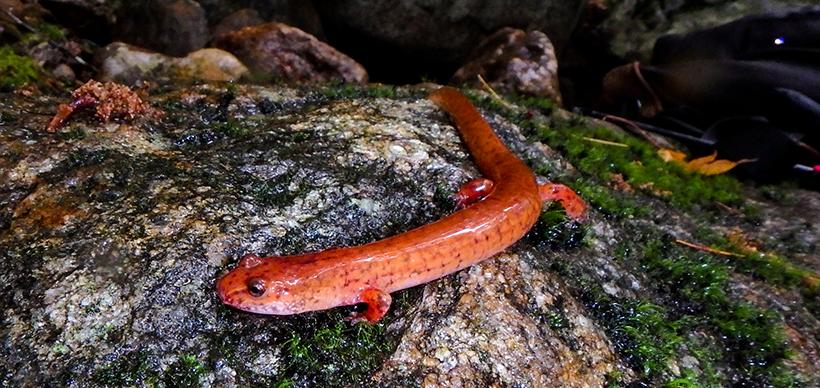- MassWildlife's Natural Heritage & Endangered Species Program
- Division of Fisheries and Wildlife
Media Contact
Marion Larson, MassWildlife

Spring salamanders (Gyrinophilus porphyriticus) were once considered rare in Massachusetts. Until 2006, they were listed as a species of special concern under the Massachusetts Endangered Species Act. After nearly 14 years, MassWildlife’s Natural Heritage and Endangered Species Program (NHESP) is spearheading a formal assessment of the species this summer. Such a measure is especially warranted by the growing concerns over potential impacts of climate change to coldwater resources in higher-elevation habitats of southern New England—areas where spring salamanders live. Updated information about this species can reveal a potentially important piece of that puzzle.
A network of trusted volunteers will assist staff in visiting a number of historically known spring salamander sites in 2019 and 2020. Surveys aim not only to confirm continued presence of the species at a given site, but also to compile baseline information of relative abundance among sites. MassWildlife staff will also be exploring areas not previously known to host spring salamanders to add our understanding of the current distribution and overall abundance of local populations.
If you have experience with stream salamanders of Massachusetts (northern dusky salamander, northern two-lined salamander, spring salamander) and would like to be an active contributor to the assessment effort, please contact Conservation Scientist Jacob Kubel (jacob.kubel@mass.gov). If you happen to encounter a spring salamander incidentally during a foray into a forested stream, please note your precise location, photograph the animal, and contact Mr. Kubel for details on how to report the observation for inclusion in the NHESP database as an official state record of the species.
Spring salamanders are the largest and most elusive of the Commonwealth's stream-dwelling salamanders, growing to 8 inches long. Juveniles and young adults are pinkish-orange, with faint, black spots or streaks that form a net-like pattern over the body. Larvae are fully aquatic and have external gills, squared snouts, small eyes, and are a yellowish-brown to grayish-lavender with fine markings. Larvae take several years to mature and metamorphose into air-breathing salamanders, reaching several inches in total length before doing so.
One of the challenges in understanding the conservation status of spring salamanders is their secretive behavior and preference for streams associated with rough terrain in remote areas. Spring salamanders spend most of their time hidden beneath large, flat stones and among cobbles in or along streambeds, making them difficult to monitor.

